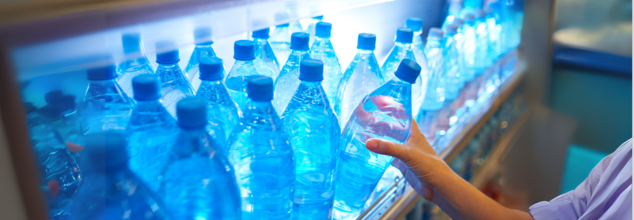- Health Conditions A-Z
- Health & Wellness
- Nutrition
- Fitness
- Health News
- Ayurveda
- Videos
- Medicine A-Z
- Parenting
Does Water Expire? Truth About Bottled Water Expiration Dates

Image Credit: Canva
You've probably asked yourself too if that old bottle of water in your pantry is still good to drink? Water is life, yet there are remaining questions about the shelf life. Whether you are stockpiling for emergencies or wondering if that bottled water left in a heated car is safe to drink, understanding if and how water "expires" is essential. This article goes into the science behind water storage and its potential risks and practical tips to ensure your water will remain safe and consumable.
Water itself does not spoil or degrade. Chemically, pure water (H₂O) remains unchanged indefinitely. However, there are issues that arise due to the containers in which it is stored and the environmental conditions surrounding the storage.
In the United States, most bottled water has an expiration date. This labeling is often misunderstood as being an indication of the water's safety, but it mainly has to do with quality. The U.S. Food and Drug Administration (FDA) confirms that commercially sealed bottled water is safe to drink indefinitely if stored properly. Over time, though, the taste, smell, and even the appearance of water may change due to interactions with its packaging.
Role of Packaging in Water Safety
Plastic Bottles and Chemical Leaching
Bottled water is mostly packed in polyethylene terephthalate, PET plastic. Even though it is light in weight, resistant, and recyclable, this material is limited in other aspects. It leaches chemicals in trace amounts in the water if heated or placed under direct sunlight. For instance, do not leave your bottled water in the hot car for an extended period.
The next is bisphenol A or BPA. This chemical has been used to soften some plastics and is known for its hormone disruption. Many producers have shifted toward BPA-free materials, but older bottles and improper storage still pose risks. Bottles carrying recycling code #7 may be BPA-contaminated. There are also concerns over microplastics and long-term storage.
Microplastics and Long-Term Storage
Over time, the plastic in the bottle may leach into the water, causing some to question health risks. In 2019, one article published in the International Journal of Environmental Research and Public Health noted that these particles exist but are usually not at high enough concentrations to pose a problem if the water is properly stored.
Also Read: What Happens When You Drink Too Much Water?
How Long Can Water Be Stored Safely?
Bottled Water
Unopened bottled water, kept in a cool, dark place, remains safe to drink for years. But manufacturers often advise that it should be consumed within two years of its manufacture date for best quality. After this period, it may start showing off-flavors or odors due to contact with the plastic.
Tap Water
Tap water, under the Environmental Protection Agency (EPA), undergoes strict standards for safety. It can be kept in pure, BPA-free bottles up to six months. Afterward, it loses its fresh flavor or becomes dirty if not properly sealed.
Rainwater
Don't drink rainwater unless treated first. It usually contains contaminants that should not reach the human stomach. It should be used to water plants if not filtered and sterilized first.
Signs That Water Has Gone Bad
Water itself doesn't go bad, but extrinsic factors make it unsafe. Always discard water that has:
An off smell: An earthy, metallic smell indicates contamination.
Coloration: Greenish or bluish coloration signifies microbial growth or rust.
Unpleasant taste: A metallic or stale taste is a hallmark of degradation.
Froth or particles: Indicate dirt, germs, or other impurities.
How to Store Water Safely?
Avoid Heat and Sunlight
Store water in a cool, dark place and out of direct sunlight. Heat breaks down the plastic, allowing chemicals to leach out more easily.
Choose the Right Containers
For long-term storage, select BPA-free or food-grade plastic containers. The best alternatives are stainless steel and glass containers, which avoid all the risks that plastic poses.
Hygiene Maintained
Wash and sanitize the container before refilling. Always seal the lids so that no bacteria get inside.
Rotate Your Stock
Use a first-in, first-out rotation system with stockpiled water. This will mean that you will use the oldest water first to keep your water supply fresh.
Is It Safe to Drink Water Past Its Expiration Date?
The expiration date on bottled water is a mark of its quality, not safety. Although the water is safe to drink past this date, it is sensible to check it for any signs of spoilage as mentioned above. Tap water that has been stored for longer periods should be checked for clarity and odor before consumption.
Plastic bottles, although convenient, degrade the environment. Only a few percent of PET bottles are recycled, while the rest remain in landfills or oceans. Choose reusable containers and tap water whenever possible to minimize plastic waste and environmental damage.
Water is one of the most precious resources in this world, yet it can be safe only if it is kept appropriately. People may tell you that water does not expire, but the fact is that packaging materials, exposure to the environment, and storage conditions may affect the quality of the water. Proper storage techniques, opting for BPA-free containers, ensure that water remains fresh, safe, and ready for consumption at any time.
This Popular Christmas Food Could Raise Your Risk of Cancer And Heart Attack

Credits: Canva
Millions of people are stocking up on food for Christmas, planning the main meal and everything that comes with the festive stretch. What many do not realise is that there is a proven link between cancer and one much-loved item that often sits on the Christmas Day plate.
While sugar is often blamed for causing cancer, that belief is not supported by evidence. In fact, only two foods have a confirmed, direct link to cancer: alcohol and processed meat. And popular pigs in blankets clearly fall into the processed meat category.
Popular Christmas Food Could Raise Your Risk of Cancer And Heart Attack
To be clear, no one is saying that eating pigs in blankets on Christmas Day will give you cancer, just as no one suggests that a single glass of wine or sherry will lead to a diagnosis. That said, recent scientific evidence shows there is no truly safe level of alcohol consumption. In a recent report, Vivek Murthy, former surgeon general of the US Public Health Service, warned that alcohol use has been directly linked to at least seven different types of cancer, and that even light or moderate drinking can raise a person’s cancer risk.
As per Mirror, both processed meat and alcohol are classified as Group 1 carcinogens by the World Health Organisation, which means there is clear evidence they can cause cancer in humans. According to the WHO, “There is convincing evidence that the agent causes cancer.” Tobacco smoking and asbestos are also listed as Group 1 carcinogens, although the organisation clarifies that this does not mean alcohol and processed meat are as dangerous as smoking or asbestos.
Cancer Research UK also states clearly, “We know for certain that processed meat causes cancer. We are as confident about this link as we are about other established causes of cancer, such as tobacco and alcohol.”
What Is Processed Meat?
The World Health Organisation defines processed meat as “meat that has been transformed through salting, curing, fermentation, smoking, or other processes to enhance flavour or improve preservation.” Sausages and bacon are commonly cited examples by both the WHO and Cancer Research UK.Cancer Research UK explains that processed meats contain chemicals that are either added during processing or formed during cooking. These include nitrates and nitrites, which help keep processed meat fresh for longer. The organisation notes, “When we consume them, nitrates and nitrites can turn into N-nitroso chemicals (NOCs), which can damage the cells lining the bowel. This damage can increase the risk of bowel cancer.”
Why Does Alcohol Cause Cancer?
Alcohol increases cancer risk through biological processes that occur as it is broken down in the body. This means that any alcoholic drink, regardless of how expensive, high-quality, or mild it may seem, carries a cancer risk. There is no safe threshold for drinking alcohol. The WHO says cancer risk “rises significantly the more alcohol is consumed,” but also points out that “the latest available data show that around half of all alcohol-related cancers are caused by ‘light’ and ‘moderate’ drinking,” defined as less than 1.5 litres of wine, less than 3.5 litres of beer, or under 450 millilitres of spirits per week.
Processed Meat And Heart Disease
In 2021, researchers at Oxford University reported that the “largest review of all large-scale studies to date shows red and processed meat increase the risk of heart disease.”
Worldwide, coronary heart disease causes nearly nine million deaths each year, making it the leading cause of death globally. Scientists from the University of Oxford’s Nuffield Department of Population Health said their analysis “showed that each additional 50g per day of processed meat, such as bacon, ham, or sausages, was linked to an 18% higher risk of coronary heart disease.”
What Is The Best Time To Eat Dinner?

Credits: Canva
Eating is something we do every day, and its connection to our weight is undeniable. Most of us concentrate on what we eat, and rightly so, because the nutritional value and calorie content of food directly impact our weight. Yet, an increasingly important factor in weight management is when we eat. Nutritionist Pooja Makhija explains the science behind having early dinners, particularly in the evening, and how this aligns with the body clock to support overall weight management.
In an Instagram video, she writes in the caption, “You don't start digesting worse at night because of the food… you digest worse because melatonin has already risen,” adding, “Melatonin climbs 2–3 hours before your bedtime, dropping your insulin sensitivity by up to 50% and switching fat cells into storage mode. So the same meal hits very differently at 7 pm vs 10 pm.”
What Is Melatonin?
Melatonin is a hormone made by the pineal gland in the brain that helps control the body’s sleep-wake cycle. Its levels usually rise in the evening, peak during the night, and fall in the early morning. Many doctors even recommend melatonin supplements to help regulate sleep patterns, though they can sometimes cause side effects, so consulting a physician is advised, as per Healthline.
How Does Melatonin Affect Your Fat Storage In Body?
In her video, Pooja grabs attention by asking, “We all know that melatonin makes you sleepy. But what if I told you that melatonin wakes up your fat cells and makes them store more? Hadn't heard of that?”
She continues, “Melatonin isn’t just your sleep hormone. It’s your body’s night mode switch. As it rises in the evening, your metabolism slows down. Insulin sensitivity drops 25 to 50 percent, glucose clearance slows, and your fat cells switch from burning energy to storing it.” Referring to a study published in the *Clinical Endocrinology and Metabolism* journal, she adds, “People who ate dinner when their melatonin was high had a 34 percent higher glucose spike. Same people, same meal, same calories—just bad timing.”
What Is Front Loading Calories?
Front-loading calories is a way of eating where most of your daily calories are consumed earlier in the day, with a big breakfast and hearty lunch and a lighter dinner in the evening. This approach matches your meals with your body’s natural circadian rhythms, improving metabolism, insulin response, and appetite control. It helps with weight management and energy levels by taking advantage of the morning metabolism, reducing late-night cravings, and supporting better sleep.
What Is The Correct Time To Have Dinner To Prevent Fat Storage And Weight Gain?
Pooja Makhija says the most effective method to prevent melatonin from triggering fat storage is to eat early dinners and front-load calories during the day.
“So when most of your calories land late at night, it’s at a time when your biology is saying, ‘I’m done for the day; I’m not burning more.’ In contrast, front-loading calories with a big breakfast, solid lunch, and small dinner means you’re eating when melatonin is low. Your insulin is sharp, mitochondria are active, and your body is in daytime burning mode,” she explains.
She concludes with a reminder: “Your fat cells have melatonin receptors, and they behave differently depending on the time of day. Front-loading isn’t a hack—it’s circadian biology. Melatonin guides your metabolism. So eat in tune with your body clock, not against it, and notice the difference.”
According to Healthline, the ideal dinner time for better melatonin regulation and metabolism is 2–3 hours before bedtime—before your body naturally begins releasing melatonin—to avoid insulin spikes and fat storage.
Afraid You Will Gain Weight With Christmas Feast? Here's What You Can Do

Credits: iStock
Christmas is meant to be joyful, but the fear of gaining weight often sneaks in between helpings of roast potatoes and dessert. There is a reason this worry feels real. Nearly half of the weight many people gain in a year tends to show up during holiday periods, and once gained, it often sticks around longer than expected. The good news is that enjoying festive food does not have to mean starting the new year with regret. Smart choices, balanced plates, and mindful eating can make all the difference.
Build your plate around plant-forward foods
Festive spreads are often richer than everyday meals, which is why vegetables play a key role in keeping things balanced. Christmas classics like Brussels sprouts, red cabbage, carrots, parsnips, onions, and even potatoes offer more than color and crunch.
Cruciferous vegetables such as Brussels sprouts and red cabbage support the body’s natural detox systems and provide compounds linked to healthy ageing.
Roasted root vegetables supply complex fibers that feed good gut bacteria, helping digestion stay on track despite heavier meals. Onions support natural cleansing processes, while cooked and cooled potatoes contain resistant starch that behaves like fiber and helps keep blood sugar steady. This also makes leftovers a surprisingly good option.
Adding grains and healthy fats further improves satiety. Quinoa provides complex carbohydrates along with complete protein, while avocado contributes heart friendly fats that help you feel full longer. Pomegranate seeds add antioxidants and support gut and heart health, making them a festive ingredient worth sprinkling generously.
Pair plants with protein for better balance
A common reason for holiday overeating is a lack of protein on the plate. Protein helps regulate appetite and keeps energy levels stable. Plant based mains such as mushroom wellingtons, nut roasts, or lentil loaves work well for this reason. Mushrooms offer antioxidants and immune supporting nutrients, while lentils provide protein, iron, and fiber without excess fat. Chestnuts stand out among nuts because they act more like a starch, making them filling but lighter than many other nut based foods.
Even for non vegetarians, these dishes can sit comfortably alongside traditional mains, adding variety and balance without sacrificing flavor.
Mindful eating matters as much as food choices
What and how you eat both matter during the holidays. Slowing down helps the body register fullness before overeating sets in. Taking time to notice the aroma, texture, and taste of food improves satisfaction, often with smaller portions. Putting cutlery down between bites and staying present at the table can naturally reduce mindless eating.
Hydration is another simple but powerful tool. Alcoholic drinks are calorie dense and dehydrating, which can increase appetite. Alternating festive drinks with water or fruit based punches helps manage intake while still allowing you to join the celebration.
Choose desserts that satisfy without excess
Dessert does not need to be skipped to stay on track. Lighter versions can be just as comforting. Fruit based options like baked apples, berry crumbles with oats and nuts, or spiced poached pears offer natural sweetness and fiber. Greek yogurt based desserts provide protein and probiotics that support digestion and help prevent overindulgence.
Dark chocolate with a high cocoa content can also fit in. A small portion enjoyed slowly with fruit delivers antioxidants and satisfies cravings without going overboard. Nuts and dates make rich, festive treats too, but portion awareness matters since they are calorie dense.
Focus on joy, not guilt
Christmas food is about connection, tradition, and pleasure. Guilt free enjoyment actually supports digestion and overall wellbeing. When meals are built around vegetables, balanced with protein, and eaten mindfully, the festive season can feel indulgent without tipping into excess. The goal is not perfection, but balance. Nourish the body, enjoy the moment, and let Christmas be both festive and kind to your health.
© 2024 Bennett, Coleman & Company Limited

